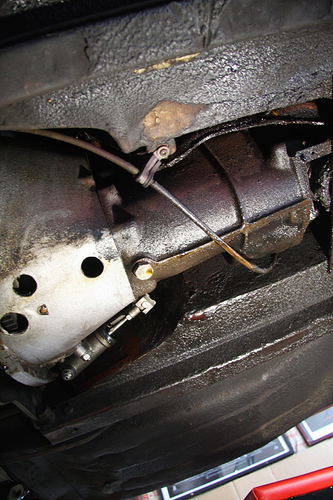Yes, although the hole is not nicely machined the size and location seems too consistent for something that shops were adding ad hoc after the fact.
I will see your two holes and raise you one…
Something weird going on here. And yes that was the speedo cable running UNDER the trans. Long story, but car in family since almost new and I know the speedo drive was replaced in the 70’s because they cut the trans tunnel to get to it. The cable no longer runs this way. but I had never paid much attention to the holes until now.
Mine looks like the same drill bit was used twice to widen the hole. I’m working on to get a good shot
with a light inside.
The rearmost hole, the one that doesn’t have the riveted cover, is directly in line with the rod that the TO bearing shaft pivots on. I wonder what the significance of that is?
Lets more oil escape, more easily?
![]()
When the retainer loosened on the rod in my bell housing it certainly insured the rod made it’s escape, never to be found again.
Jolly good! Factettes to consider:
A)" I would be surprised…" Color me surprised. Prediction validated
B) “All the ones I’ve seen…” Statement remains unimpeached, sample validated.
C) The product no longer exists… Hypothesis re suitability validated
D) Common incorrect use even by experts like Twist. Scepticism validated 
As it happens I have seen deep groove roller bearings on the drive side mainshaft of motorbike cranks, to give good axial location, albeit the roller was chosen to bear the pulling/bending loads on the overhanging drive sprocket. I think a taper roller would be superior for releasing the clutch so I could quite believe it if I see one. It could be the XK example is correct and the ones I haven’t cut to pieces were rollers after all, behind the sheet metal rubbing face?
Gaffer’s tape woulda prevented that…
I just went back and looked at that topic. His explanation makes sense and then he says it’s not needed, but it certainly makes installation of the rod easier.
.
Looking in the Bentley manual I see Figure 4 on page 139 (or page E7 of the factory manual) looks like it shows the second hole.
[quote=“John_Walker1, post:50, topic:371470”]
Looking in the Bentley manual I see Figure 4 on page 139 (or page E7 of the factory manual) shows the second hole.
[/quote].
Now THAT is a find! So much for the theory that they were not done by the factory…
Here is the scan of the page.
Click on the picture and then click on it again and it gets full size.
Jaguar subcontracted the bell housings. I wonder if the hole with the cover was created by the sub and the second hole was added by the Jaguar factory to aid assembly. That would account for the hand drilled look.
John,
Sorry if I caused confusion. My post was supposed to read “Now THAT is a find!”, not “No THAT is a find!” (I’ve corrected it now). So I think that you’ve clearly proved that the factory was responsible for the 2nd hole. How do we account for the fact that some cars don’t have it? I guess that, like other things, it could have been missing from the very earliest cars. Also, if the hole was hand made by the factory during production (rather than being in the original casting), it’s possible that any bellhousings supplied as spares might not have it. Maybe the factory stopped making the hole at some point too?..
Not a problem, I knew exactly what you meant.
That’s what I’m thinking; the second holes were added at the factory to aid assembly and they didn’t always do it. According to Haddock/Mueller two different suppliers provided bellousings. Perhaps one supplier’s castings were slightly different and required the hole while the other supplier’s product didn’t.
I wonder why the factory didn’t put a rubber plug in the hole. They thought it was important enough to provide a cover for the front hole at the flywheel.
My car had the second hole, I owned it from when it was 9 years old.
pauls
My thinking. If the manufacturer of the bell housing delivered something like that Jag would certainly have balked. If performed at the assembly line it would explain why it doesn’t have a machined appearance.
If made by the mfgr. I can only assume that they used this hole to drill the pin’s bosses inside the case. That would explain why the edges are so oddly shaped. One hole to get the bit in, the sloppiness made by the use of the bit, guide, etc., as it was inserted and withdrawn, probably turning the whole time.
Odd that one hole got a cover, the second didn’t. Why?



